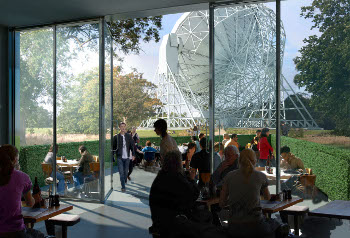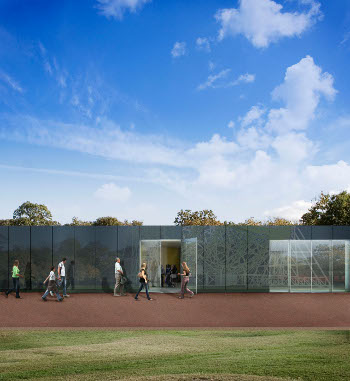
Artist's impression of the admissions building for the planned new Jodrell Bank Discovery Centre.
Credit: University of Manchester & Feilden Clegg Bradley Studios.

Artist's impression of the view from the cafe in the admissions building for the planned new Jodrell Bank Discovery Centre.
Credit: University of Manchester & Feilden Clegg Bradley Studios.

Artist's impression of the Space Pavilion in the planned new Jodrell Bank Discovery Centre.
Credit: University of Manchester & Feilden Clegg Bradley Studios.
Jodrell Bank plans new 'live science' visitor centre
10 March 2010
A new Discovery Centre to inspire budding young scientists and showcase cutting-edge research 'as it happens' is being planned for The University of Manchester's famous Jodrell Bank Observatory.
A formal planning application for the work has just been submitted to Cheshire East Council and funding is being sought for the plans, which are predicted to attract thousands of extra visitors to the site - part of the University's School of Physics and Astronomy.
The project, which it is hoped will form 'phase one' of a wider redevelopment of the visitor facilities, has a total floor space of 1,000 square metres, and will include:
- A Planet Pavilion entrance building including an orientation centre and stylish glass-walled café with spectacular views of the Lovell telescope
- A Space Pavilion incorporating a multi-purpose exhibition, events and education space
- Landscaping of the Arboretum to create a new Galaxy Maze and a Space Garden.
The planned development has strong support from Sir Bernard Lovell, founder of the Jodrell Bank Observatory and creator of the Lovell Telescope, who lives nearby.
If funding is found, the first building could be complete around 3-4 months after the diggers arrive on site, with all work completed within 12 months.
Current visitor facilities will be kept open as much as possible if the development goes ahead - with a fully booked schools programme continuing over the summer months, alongside a number of events for the public and 'Friends' of Jodrell Bank.
Astronomers would continue to carry out observations and world-class science while the redevelopment work takes place.
Dr Teresa Anderson, Director of the Jodrell Bank Discovery Centre, said:
"This is a really important milestone for us and we're absolutely delighted that our project is moving forward.
"It has taken considerable work to get to this point and we would like to thank the Northwest Regional Development Agency (NWDA) and a range of other major stakeholders including the local community and our visitors for their feedback and support.
"Alongside plans to redevelop our facilities, we will be taking the opportunity to revitalise our visitor programme, and we look forward to welcoming lots of new people to Jodrell Bank in the future."
Lord Keith Bradley, chair of the University steering group for the project, said:
"The redeveloped facilities at Jodrell Bank will open our doors to even more people, allowing them to engage with the University's world leading research - and inspiring young people to become the scientists of the future."
Sir Bernard Lovell said:
"As the founder of the Jodrell Bank Observatory, I am delighted to hear that there are plans to upgrade the facilities for visitors to the site.
"The very modern design that has been developed reflects the fact that the work of Jodrell Bank is at the forefront of research into astrophysics. The new facilities will pass on the spark of inspiration to the school pupils who are the scientists of the future. I look forward to this development going ahead very soon."
Consultation and feedback sessions on the plans have already been held for local residents and scientists working on the site.
The architect for the project is Feilden Clegg Bradley Studios. The firm won the RIBA Stirling Prize in 2008 and designed the National Trust's new headquarters and the visitor centre at the Yorkshire Sculpture Park. Capita Symonds is the project manager.
Jodrell Bank has been instrumental in numerous scientific discoveries, including providing the best test of Einstein's theory of gravity, General Relativity. In 1957 the Lovell Telescope was the only telescope in the world powerful enough to track the rocket that carried the Soviet satellite Sputnik into space.
The facility's work has helped astronomers to study how planets and stars form and reveal the nature of supernovae, neutron stars and black holes. It has also played a major role in the discovery of quasars and gravitational lenses, and in understanding pulsars.
Jodrell Bank currently operates the UK's e-MERLIN network of telescopes on behalf of the Science and Technology Facilities Council (STFC). Once fully operational, this fast and powerful network of seven radio telescopes will allow astronomers to carry out observations which previously took several years in just a single day.
Jodrell Bank also hosts the global headquarters for the Square Kilometre Array radio telescope - a huge £1 billion international project that will survey the sky thousands of times faster than any imaging radio telescope ever built.
Anyone wanting to keep up to date with progress and latest developments can visit the Jodrell Bank Discovery Centre website. People also have the option to join the New Friends of Jodrell Bank scheme.
Notes for editors
Dr Teresa Anderson is available for comment by arrangement.
For more information please contact Michael Addelman, Media Relations Officer, The University of Manchester, Tel 0161 275 0790 / 07717 881567.


